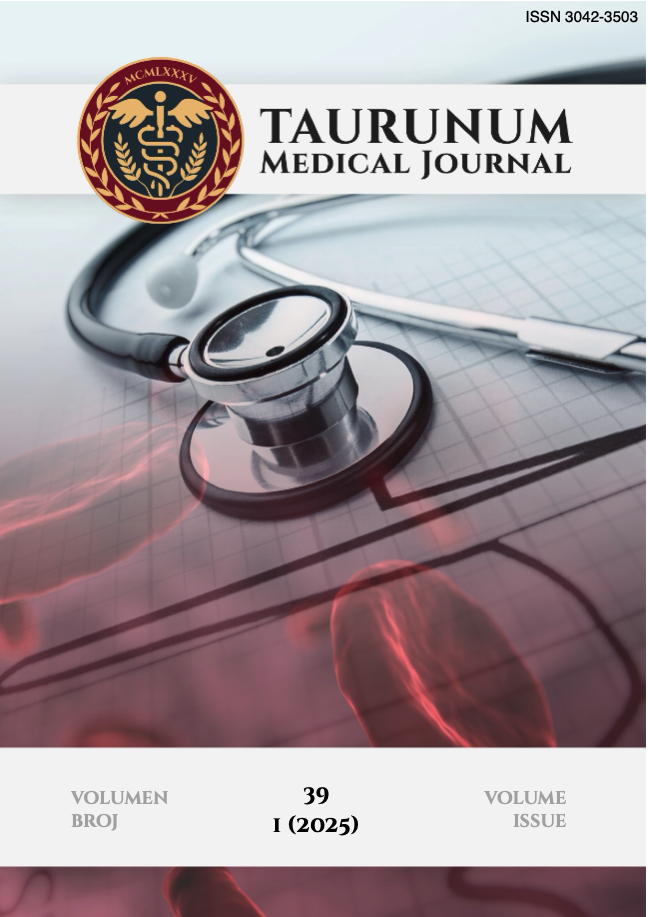Current issue

Volume 39, Issue 1, 2025
Online ISSN: 3042-3511
ISSN: 3042-3503
Volume 39 , Issue 1, (2025)
Published: 31.03.2025.
Open Access
Welcome to Issue 39, No. 1 – the first of our two annual publications for this year. Inside, you'll find a curated selection of articles. Start your year with the essential knowledge and perspectives offered in this timely edition
All issues
Contents
01.04.2018.
Special Session: Residents Session
Hyperostosis frontalis interna: case report
Introduction: Hyperostosis frontalis interna is progressive, irregular thickeness of the frontal bone s internal table. It has been associated with a wide range of syndromes, though we know now that it can occur as an independent entity. Etiology is still unclear, but the most probable hyphothesis is alteration of steroid sex hormons, proven in high frequency among postmenopausal women. It is mostly asympthomatic or it has been accidentally diagnosed after endocranial trauma or postmortal. Because of its progression, in some cases it can cause cerebral cortical compression and varible neurological symptoms. Case report: We present a case of 27 years-old women, hospitalized in Neurosurgical Clinic, because of severe headaches lasting for 3 month. The head CT scan showed a massive, expansive lesion in right frontal bone, with spearing of the superior sagittal sinus and skull midline. Bone bulging does not affect outer table of the frontal bone, but only diploic space and inner table. Pathological analysis of the frontal bone showed marked trabecular thickening both cortical and spongy bone, with corticalisation of spongy bone. Haversian canals showed reduction in number and size, and light fibrosis. The lamellas of the spongy bones were enlarged, with prominent interlamellar bridges and the reduction of interlamellar spaces.In purpose of closer determination of etiopathogenesis,we did immunohystochemical analysis of Estrogen, Progesteron and Androgen receptors in dural tissue. Immunohistohemical stain confirmed nuclear expression of Estrogen and Androgen receptors in dural fibroblasts.Progesterone receptors were negative on immune stain. Conclusion: These results could support the hormonal theory of the cause of hyperostosis frontalis interna.
Ljubica Simic, Savo Raicevic, Danijela Bracanovic, Danijela Djonic, Jelena Sopta
01.04.2018.
Poster session
A rare localization of alveolar soft part sarcoma: a case report
Aim: We present the case of a rare localization of the alveolar soft part of the sarcoma in the visceral organ. Introduction: Alveolar soft part sarcoma (ASPS) is a rare mesenchymal tumor typically occurring in young patients, more frequently in females. Common localization of ASPS is skeletal musculature of lower extremities. ASPS in visceral organs usually represents a metastasis from the more common primary location in skeletal muscles. ASPS is characterized by a tumor-specific translocation which causes the fusion of the TEF3 with a ASPL gene (also known as ASPSCR1). Case report: Female 47 years old was admitted to hospital due to abdominal pain. Urgent surgery was performed due to ileus. Ileal tumor was detected intraoperatively as a cause of ileus. Tumor was infiltrated whole intestinal circumference, with dimension 70mm x 47cm and evident perforation. Histology showed well-defined nests of pleomorphic cells separated by delicate fibrovascular septae. Within described nests there is a prominent lack of cellular cohesion, representing for the distinctive pseudoalveolar pattern. Immunohistochemical stadies were diffusely positive for TFE3 and focally positive for CD34 and alpha-SMA and negative for panCK, DOG-1, CD117, S-100, HMB45, Desmin. Immunopositivity for Ki67 was present in 20% of tumor cells. FISH analysis was done using locus specific dual color break-apart TFE3 (3 and 5 ) probe and rearrangement in the TFE3 gene was confirmed. Conclusion: Despite the fact that ASPS is rare mesenchymal tumor in visceral organs it have to be considered as possible diagnosis especially in cases with typical histological features and immunohistochemical profile. Definitive diagnosis of ASPS must be confirmed by FISH analysis.
Radmila Jankovic, Jelena Sopta, Sanja Cirovic, Martina Bosic, Jovan Jevtic, Ljubica Simic



